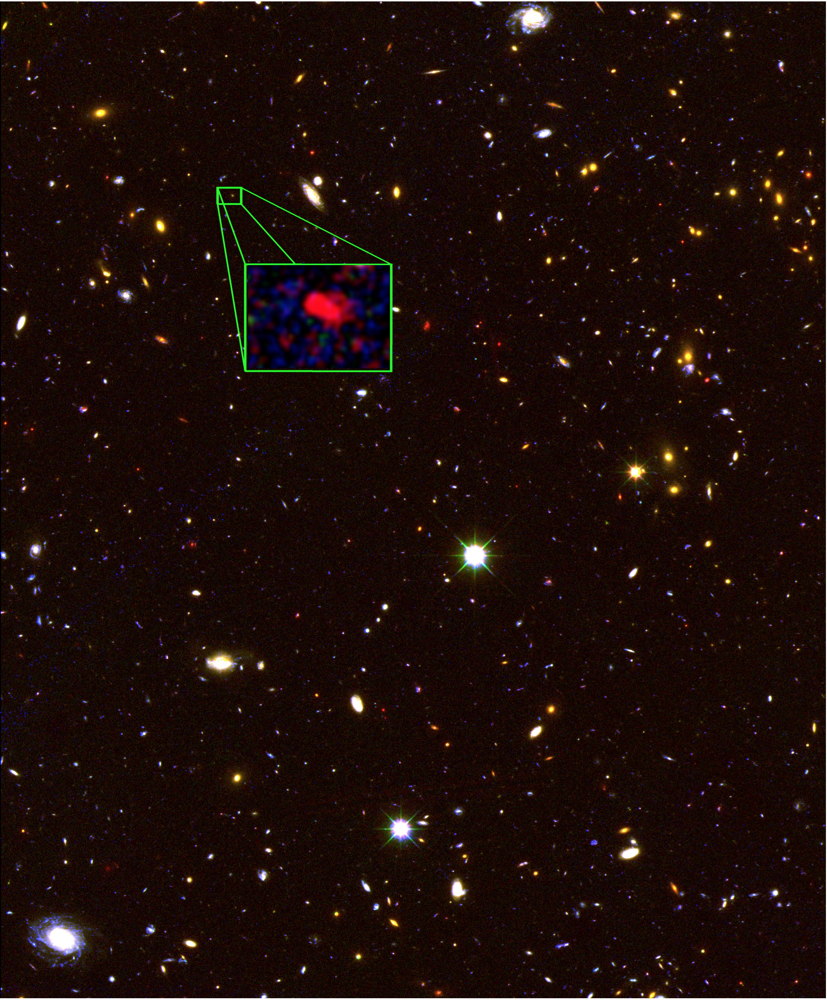Ancient Galaxy Is Farthest Ever Seen

Scientists have discovered the most distant and ancient galaxy ever spotted.
By using data collected by the Hubble Space Telescope and observations from the Keck I telescope at the Keck Observatory in Hawaii, astronomers have now confirmed that the galaxy designated z8_GND_5296 formed within 700 million years after the beginning of the universe, making it the oldest and most distant galaxy ever verified.
Because the galaxy is so far from Earth, scientists were able to observe z8_GND_5296 as it would have appeared about 13.1 billion years ago. [How Galaxies are Classified by Type (Infographic)]
"The most exciting aspect in general of what I do is the fact that we can learn about what things were like in the very early universe," Steven Finkelstein, the lead author of the new galaxy study in Nature and an astronomer at the University of Texas, Austin, said. "Because the speed of light is constant, light takes time to get here, we're not seeing these galaxies as they are now. We're seeing them as they were 13 billion years ago which is 95 percent of the way back to the Big Bang."
Scientists are seeing the galaxy as it was when it was very young. Many of the now old stars that were part of the galaxy are probably still in existence today, but they might be part of a bigger galaxy, Finkelstein told SPACE.com
It's possible that Hubble has detected galaxies that are farther away, but z8_GND_5296 is the farthest galaxy confirmed by follow-up observations using other astronomical instruments, scientists said.
Hubble's CANDELS (Cosmic Assembly Near-infrared Deep Extragalactic Legacy) survey has discovered about 100,000 galaxies, and the team of astronomers observed 43 of them for the new study, published in the journal Nature.
Breaking space news, the latest updates on rocket launches, skywatching events and more!
Scientists use hydrogen to calculate distances of galaxies. The research team searched for a hydrogen emission line in the 43 galaxies they observed, but they only saw the emission line in z8_GND_5296. This surprised the astronomers because they were expecting to find about six galaxies with the emission line,
"This work shows that, with new technology, it has finally become possible to make significant advances in the detection of yet more distant galaxies," Dominik Riechers, an astronomer who wrote a commentary about the new study, told SPACE.com via email.
"However, the work also mentions that they expected to find six galaxies at similar distances, but just were able to confirm one," he added. "Thus, we know now that we will be able to push the frontiers in studies of the early universe further, but it may be even harder than anticipated."
It's possible that scientists got these results from peering deeply into "the era when the universe made its transition from an opaque state, in which most of the hydrogen gas between galaxies is neutral, to a translucent state, in which most of the hydrogen is ionized," representatives from the University of Texas at Austin said in a statement.
Galaxy z8_GND_5296 has another extraordinary quality: The most distant and ancient galaxy also produces stars about 150 times more quickly than the Milky Way. While the Milky Way may produce about one or two sunlike stars each year, z8_GND_5296 birthed about 300 per year approximately 13 billion years ago, according to the astronomers' observations.
The new record holder for distance is in the same part of the sky as the previous record holder, which also has a high rate of star formation.
"It could be that we found two weirdoes, but now we've found two weirdoes in the same Hubble image in this tiny little region of the sky," Finkelstein said. "More than likely, they're not weirdoes. I think what it's telling us is that in the distant universe you can actually make a decent number of these galaxies."
Editor's Note: This story was updated to reflect a correction at 2 p.m. EDT. An earlier version of this story quoted Steven Finkelstein as saying that the speed of light is not constant. The speed of light is constant and the quote has been corrected.
Follow Miriam Kramer @mirikramer and Google+. Follow us @Spacedotcom, Facebook and Google+. Original article on SPACE.com.

Miriam Kramer joined Space.com as a Staff Writer in December 2012. Since then, she has floated in weightlessness on a zero-gravity flight, felt the pull of 4-Gs in a trainer aircraft and watched rockets soar into space from Florida and Virginia. She also served as Space.com's lead space entertainment reporter, and enjoys all aspects of space news, astronomy and commercial spaceflight. Miriam has also presented space stories during live interviews with Fox News and other TV and radio outlets. She originally hails from Knoxville, Tennessee where she and her family would take trips to dark spots on the outskirts of town to watch meteor showers every year. She loves to travel and one day hopes to see the northern lights in person. Miriam is currently a space reporter with Axios, writing the Axios Space newsletter. You can follow Miriam on Twitter.

